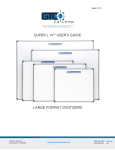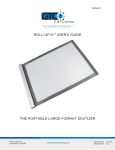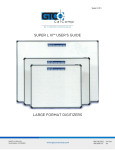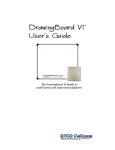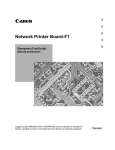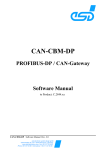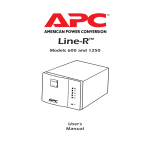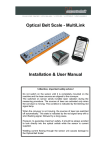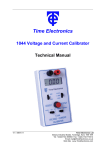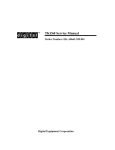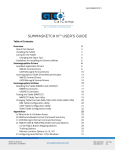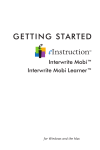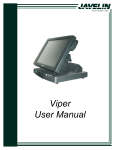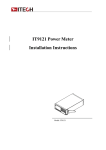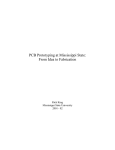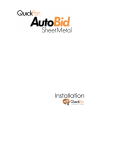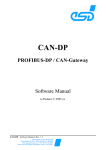Download User`s Guide - GTCO CalComp
Transcript
DrawingBoard VI 1 DrawingBoard VI 2 Table of Contents Introduction Parts Checklist What You Will Need to Use DrawingBoard VI PC Requirements For a USB Installation For an Optional Serial Installation DrawingBoard VI Overview Active Area Menu Strip Indicator Light Transducer Setting Up Your DrawingBoard VI Preparing the Large Format DrawingBoard VI Mounting on the Stand Attaching the Optional Accessory Tray or Plan Holder Software Configuration Configuring Non-Wintab Applications Installing the TabletWorks Driver Hardware Configuration USB Connection Optional RS-232 Serial Connection Tablet Power-On Customizing the Tablet Overview of the Menu Strip Selecting a Pre-Programmed Setup Selecting a Custom Setup Tablet Options Recommended Setups for Common PC Software Applications Restoring a Pre-Programmed Setup Learning the Basics Using the Transducer Using the Cursor Using the Pen Learning Basic Movements Clicking and Double-Clicking Dragging 4 5 5 5 5 6 6 6 7 7 7 7 8 8 8 9 9 9 9 10 11 11 12 12 13 14 15 21 26 27 27 27 28 29 29 29 DrawingBoard VI 3 Caring for the Tablet and Transducer Cleaning the Tablet Cleaning the Cursor Replacing the Pen Tip Replacing the Cordless Pen Batteries Replacing the Cordless Cursor Batteries Troubleshooting Reducing Monitor Interference Changing the Frequency of the Cordless Cursor Changing the Frequency of the Cordless Pen Changing the Frequency of a Corded Transducer Tablet Checklist Computer Checklist Software Checklist Does the tablet work with some software? Did the software work in the past? Troubleshooting Chart Returning your Tablet for Repair Repacking for Shipment Parts and Accessories Glossary Regulatory Statements and Warranty Radio and Television Interference Canada Declaration of Conformity European Union Emission Directive European Union WEEE Directive Japan Bescheinigung des Herstellers/Importeurs Limited Warranty for the DrawingBoard VI 29 29 30 30 30 31 32 33 33 33 34 34 34 35 35 35 36 37 37 38 39 43 43 44 45 47 47 48 48 49 DrawingBoard VI 4 Introduction DrawingBoard VI belongs to a class of computer input devices called graphics tablets, or digitizers. A digitizer is an electronic tablet work surface. The position of a transducer, a handheld cursor or stylus pen, on the work surface of the DrawingBoard VI is converted – digitized – into data for computer processing. Data output from the DrawingBoard VI digitizer is in the form of an X/Y coordinate pair that pinpoints the precise location of the transducer on the tablet surface. By placing a drawing or sketch on the tablet’s surface and tracing over it, graphical information can be easily converted into accurate digital information for entry into the computer. DrawingBoard VI digitizers utilize the same Advanced Function Technology that has set the world standard for performance since 1975. These high performance tools are engineered with a state-of-the-art positioning grid to ensure reliability, performance and quality. Multiple accuracy versions are available to meet specific system requirements. The DrawingBoard VI family of small and large format digitizers boasts the highest resolution, 12,700 lines per inch, on the market today, unparalleled accuracy and a wide range of sizes, providing the perfect solution when the work demands precision data input, particularly over a large surface area. CAD, GIS, engineering, textile and apparel designers appreciate the variety of cordless and corded cursors and stylus pens available to use with DrawingBoard VI. An integrated mounting channel on the large format frame allows components, such as an accessory tray, to be quickly and easily mounted. Easy-to-use software and programmable function keys round out the picture of a powerful, versatile tool that can be configured to meet the needs of any application environment from drawing, animation, presentation graphics and desktop publishing to drafting and mapping. The high-productivity DrawingBoard VI can be used as both a digitizer and a mouse, eliminating the need for multiple devices at your computer. In order to send data to a digitizing application, DrawingBoard VI must be physically connected to a computer and should be able to transmit data in such a way that the digitizing application recognizes and understands it. Before setting up DrawingBoard VI, you should determine: Requirements of the digitizing software application being used Whether the digitizing application requires software drivers to communicate with DrawingBoard VI Hardware communications connection (USB or serial) being used between DrawingBoard VI and the computer DrawingBoard VI 5 Parts Checklist DrawingBoard VI digitizer/tablet Transducer (corded or cordless pen, 4-button or 16-button cursor) USB cable CD-ROM with Windows Drivers and user’s manual Universal mounting brackets Registration card Optional Equipment RS-232 serial kit (power supply and cable) Accessory tray* Clear overlay* Manual lift/manual tilt* Magnifier lens for high-accuracy cursor* *For Large Format Digitizer Only What You Will Need to Use DrawingBoard VI PC Requirements DrawingBoard VI is equipped with both a USB and RS-232 serial interface, which requires an optional RS-232 cable and power supply. It is compatible with a majority of industrystandard PCs. The TabletWorks CD contains drivers provided by GTCO CalComp by Turning Technologies and is the only software described in this manual. TabletWorks supports reduced functionality Wintab and TabCon-compatible applications. If you are not sure which drivers are required, please consult with your application vendor. A USB connection requires the use of a TabletWorks driver, while a serial connection requires the use of a TabletWorks driver and/or a custom application program. After installing the TabletWorks software, DrawingBoard VI will work with all Windows-based applications specifically designed for use with digitizers. For a USB Installation Microsoft Windows 98 SE, ME, 2000, XP, Vista, 7 or 8 One available USB port 10 MB of free disk space Application software that accepts digitizer input via the Wintab API or TabCon API DrawingBoard VI 6 For an Optional Serial Installation Microsoft Windows 98, ME, NT 4.0, 2000, XP, Vista, 7 or 8 One available RS-232C serial communication port (Serial signal levels must conform to EIA RS-232C specifications) 10 MB of free disk space Application software that directly accepts digitizer input via the computer’s RS-232C serial port, or via the Wintab API or TabCon API Overview The DrawingBoard VI digitizer (large format shown here) consists of: Active Area The drawing area – Active Area – is the portion of the tablet surface designated for digitizing. Its boundaries are marked at each corner by a right-angle crop mark on large format tablets. On small format tablets, the Active Area is delineated by the overlay – not including the menu. DrawingBoard VI 7 Menu Strip The Menu Strip is the row of keys located in the lower left corner of the large format tablet and across the top of the small format tablet. You can use the keys to customize your tablet, or to assign macros to Configuration keys for greater productivity. Indicator Light The power/proximity LED in the upper right corner of the large format DrawingBoard VI frame or the proximity/configuration light above the Menu Strip on the small format tablet is the Indicator Light. It remains off when the power is on. However, when the transducer is in prox (within the range) of the Active Area, the LED is solid green. Transducer Two types of transducers can be used with DrawingBoard VI: pens and cursors. Both are available in corded and cordless versions. The corded transducers receive power from the digitizer. Cordless transducers are powered by batteries. They will go into a battery-saving Sleep Mode when no button has been pressed for one to five minutes, depending on the type of transducer being used. To reactivate a sleeping transducer, press one of its buttons. Cursors The cursor is similar in appearance to a mouse, except that it has an attached lens with crosshairs for highly accurate detail work. Cursors are available in 4 or 16 button models. In addition, there is a special 16 button cursor available with high-accuracy digitizers. Pens Each pen is similar in appearance to a ballpoint pen. The pen transducer has three buttons, two on the side of the barrel and one in the pen tip. Three different types of pens are identified by a colored ring on the pen barrel – the Click Tip has a light blue ring; the Pressure Tip, a black ring; and the Lite Touch Tip, a red ring. Setting Up Your DrawingBoard VI The instructions below describe how to setup your DrawingBoard VI. Before you begin, please take a moment to fill out and mail the Warranty Registration Card or register your digitizer on our website at http://www.gtcocalcomp.com/warranty-information. DrawingBoard VI 8 Preparing the Large Format DrawingBoard VI Mounting on the Stand Place DrawingBoard VI on a table, desk or drafting table or mount it on a stand or pedestal. The tablet’s Universal Mounting Brackets attach directly to those stands that have tilt arms. (The old style stands with tilt pads require right-angle mounting brackets, which are attached to the tilt pads. The tablet’s Universal Mounting Brackets are then attached to the right-angle mounting brackets.) Center the tablet over the attached Universal Mounting Brackets and screw the Thumbscrews into the T-Nuts in the mounting channel in the tablet’s frame. Attaching the Optional Accessory Tray or the Optional Plan Holder Additional T-Nuts have been included in the perimeter mounting channels on the DrawingBoard VI frame. You can position the Plan Holder or Accessory Tray (see Parts and Accessories) where it is most convenient for you by attaching it to any one of the available T-Nuts. The following instructions and the graphic below detail the installation of the Accessory Tray. Simply slide the Tray Rails into the channel and line up the hole in the tray with the hole in the T-Nut. Tighten the Thumb Screw to secure the Accessory Tray. DrawingBoard VI 9 Software Configuration Software drivers provide the communication bridge between your digitizing software application and DrawingBoard VI. Install only the drivers necessary for the DrawingBoard VI to work with your application software. If you are not sure which drivers are required, consult with your application vendor. Configuring Non-Wintab Applications for Optional Serial Interface Only Many application programs provide configuration information for specific digitizers. If the DrawingBoard VI digitizer is not listed, you can use the configuration for GTCO CalComp by Turning Technologies Digi-Pad Type 5 or Type 5A (T5/T5A), CalComp 9100/9500, or Summagraphics Microgrid III or ID Series. Installing the TabletWorks Driver Insert the CD into the CD-ROM drive on your computer. The installer will autoload. If it does not, click on the Start button on the Windows Task Bar and select Run from the menu. Type X:\setup.exe (X represents the CD drive letter). Follow the onscreen prompts to complete the driver installation. A TabletWorks icon will display in the System Tray on the Windows Task Bar. Right click on the icon to display the TabletWorks Menu, which provides access to all the TabletWorks features. Hardware Configuration When you use the USB interface, no data output configuration is required. When you use the optional serial interface, DrawingBoard VI must be configured to send data in a format that is compatible with the application software. Different applications have different requirements when interacting with a digitizer. Determine if you have not already, which communication connection you will be using – USB or serial. 1. Connect the corded transducer – cursor or pen – to the appropriate jack on the digitizer’s Connector Panel. The connector is keyed and will fit only the correct jack. Do not force it. DrawingBoard VI 10 USB Connection DrawingBoard VI USB port connection is USB 1.1 and 2.0 compatible. When the digitizer is connected to the USB port, Windows will recognize that there is a new device connected. If Windows displays the Found New Hardware prompt, follow the onscreen instructions to complete the driver installation. 1. Connect the interface cable to the USB jack on the DrawingBoard VI Connector Panel. The connector is keyed and will fit only the correct jack. Do not force it. 2. Attach the other end of the USB cable to any one of the USB ports on your computer or USB hub. Turn the power switch on. The digitizer will beep once, indicating it has power. DrawingBoard VI 11 NOTE: Power is supplied through the USB port. No additional power source is needed for a USB installation, even when you are using the DrawingBoard VI with a corded high-accuracy cursor. Optional RS-232 Serial Connection 1. Connect the RS-232 serial cable to the serial jack on the Connector Panel. The connector is keyed and will fit only the correct jack. Do not force it. Attach the other end to an RS-232 serial port on your computer. 2. Plug the power supply into an AC outlet. Join the power supply to the appropriate jack on the Connector Panel. Turn the power switch on. The digitizer will beep once, indicating it has power. Tablet Power On The DrawingBoard VI power switch is located at the rear of the tablet on the Controller Connector Panel. When turned on, the DrawingBoard VI’s Indicator light will begin blinking. If you are using a cordless transducer, turn it on by pressing any button on the tool. The Indicator light will glow steadily when the transducer is inside the Active Area of the tablet. When the transducer moves outside the Active Area, the Indicator light will go off. DrawingBoard VI 12 Customizing the Tablet Tailor DrawingBoard VI digitizer and transducer to suit your individual work requirements using TabletWorks. TabletWorks is a Windows program included with the digitizer software that helps you use the full capabilities of your DrawingBoard VI. You can map your digitizer to the screen area and program stylus and cursor buttons with custom macros. To learn how to use TabletWorks, please refer to TabletWorks Help on the CD. If you have chosen to use the optional serial interface, you will be able to customize the tablet data format and communications parameters using the Menu Strip, described below. Overview of the Menu Strip for Use with the Optional Serial Interface Only The Menu Strip is composed of: Config/Exit Key The Config/Exit key turns Configuration Mode ON and OFF. 3 Bank Keys There are three Bank keys: A, B and C. Each bank has a different set of tablet options that are available through Configuration key combinations. 18 Configuration Keys through They keys numbered 1-18 can be used as both Configuration and Macro keys. When the tablet is in Configuration Mode, the keys function as Configuration keys. These keys allow you to set specific tablet options by turning different combinations of Configuration keys ON or OFF. When Configuration Mode is OFF, the keys function as Macro keys. Macros can be recorded only with the TabletWorks software (see TabletWorks Help). DrawingBoard VI 13 3 Save and 3 Restore Keys The Save and Restore keys work hand-in-hand. They are used to save, or recall/restore, a setup to or from one of three Save Areas. The tablet comes with three pre-programmed setups. You can use these setups directly or overwrite them with your own. The Default Save Key controls the first Save Area. The setup saved to this area is activated whenever you power-up the digitizer. We recommend you save the setup you use most often as Default. Selecting a Pre-Programmed Setup There are three pre-programmed setups available with DrawingBoard VI: GTCO CalComp by Turning Technologies DP5 High Resolution Binary Summagraphics MM 1201 CalComp 2000 ASCII These setups are commonly used within software applications as required tablet formats. They are stored in Save Areas Default, 2 and 3, respectively. Check the manual that came with your software package to see if your application requires one of these preprogrammed setups. The Default setup is available when you power on the digitizer. To select one of the other setups: 1. Turn on Configuration Mode by clicking on the Config/Exit key. 2. Click on the desired Restore key. 3. Click on the Config/Exit key again to exit Configuration Mode. The new setup is activated. DrawingBoard VI 14 The following table lists the tablet options used by the pre-programmed setups. Mode Baud Rate Data Bits Parity Data Rate Resolution Output Format Emulation Default Run 9600 8 None 125 pps 1000 lpi Format 23 GTCO TTech DP5 High Resolution Binary Save 2 Track 9600 8 Odd 150 pps 500 lpi Format 30 Summagraphics MM 1201 Binary Save 3 Point 9600 7 Even 125 pps 200 lpi Format 0 CalComp 2000 ASCII Selecting a Custom Setup You can setup specific tablet options by turning different combinations of Configuration keys ON or OFF. The available tablet options are listed below. To setup the tablet: 1. Turn on Configuration Mode by clicking on the Config/Exit key. 2. Click on the Bank key where you need to work (A, B or C). You can determine which bank you are in by placing the transducer over one of the Bank keys. The Indicator light is on if the Bank is active. 3. Determine whether the Configuration keys are ON or OFF by placing the transducer over each key. If the key is ON, the Indicator light is ON 4. Repeat steps 2 and 3 for the remaining Banks as required. DrawingBoard VI 15 5. After you have completed your setup, save it by clicking on one of the Save keys. 6. Exit Configuration Mode by clicking on the Config/Exit key. Tablet Options The following sections show the various tablet options available through Configuration keys on the Menu Strip. Follow the procedure described on the previous page, using the keys shown for the option. The circles represent the Indicator light on the tablet: DrawingBoard VI 16 Defining operating mode Setting up increment mode Turning on prompt mode Setting up data rate for CalComp 2000 format DrawingBoard VI 17 Setting up data rate for Summagraphics MM ASCII format Setting up data rate for Summagraphics MM binary format Setting up resolution Resolutions up to 10,000 lpi are available on the large format, high-accuracy tablets for applications that support it. DrawingBoard VI 18 Setting up format DrawingBoard VI 19 Adding line feed Setting up data/stop bits Setting up baud rate Setting up parity Setting corded frequency Using Summagraphics MM or CalComp 2000 commands DrawingBoard VI 20 Using ESC for 9X00 commands Sending data out of proximity Turning on pressure pen data Turning on pen height data Turning on pen tilt data Turning on pen tilt correction Setting up CTS line enable Removing CR on ASCII formats DrawingBoard VI 21 Controlling pen sound Controlling tablet speaker Recommended Setups for Common PC Software Applications The following sections show the Configuration key setups for some common PC software packages. Setup the Configuration keys as shown below (see Selecting a Custom Setup). The circles represent the Indicator light on the digitizer. DrawingBoard VI 22 DrawingBoard VI 23 DrawingBoard VI 24 DrawingBoard VI 25 DrawingBoard VI 26 Restoring a Pre-Programmed Setup When you save a custom setup to one of the Save areas, the pre-programmed setup will be overwritten. To restore the original setup, place the Configuration keys as shown below, following the steps in the Selecting a Pre-Programmed Setup procedure. The circles represent the Indicator light on the digitizer. DrawingBoard VI 27 Learning the Basics You will find that using your DrawingBoard VI tablet is as easy or easier, than using a mouse. The DrawingBoard VI transducers are more accurate than a mouse, giving you greater control over your movements. Using the Transducer The transducer does not need to be in contact with the tablet surface in order for the tablet to sense its presence. It can be detected up to ½” above the Active Area. When the transducer is in the zone above the surface of the digitizer, it is referred to as being in prox. The Indicator light will go from a blinking green light to a solid green light when the transducer is in prox of, or touching, the tablet’s surface. The in prox zone allows you to trace through materials placed on the digitizer’s surface, such as drawing or a book. Before using the transducer, be sure that Sleep Mode is turned off by pressing a button, or in the case of the pen, touching the tip of the tablet’s surface. Using the Cursor When you use the cursor, the intersection point of the crosshairs on the lens identifies the point you are selecting. The crosshairs are etched on the bottom of the lens to increase accuracy. For maximum precision, look through the lens from a position directly over it. Button 0, the yellow button, is used as the pick, or left mouse, button. All other buttons are defined by the TabletWorks software, or through your own software application. High-Accuracy Cursor (Large Format Only) To illuminate the lens area of the high-accuracy cursor, press and hold any button in the far right column (3, 7, B, or F); at the same time, press and hold any button in the far left column (0, 4, 8, or C). The right column button must be held down while pressing the left column button. This same procedure turns the illumination off. The illumination defaults to off when the tablet is first powered on. Because you will always need one right column button and one left column button free to control the cursor illumination, you should reserve one button in each column from any macro recording. DrawingBoard VI 28 Using the Pen There are three variations of pens: the click tip, the pressure tip and the lite touch tip. The differences among these pens are tilt and height-sensitivity. On all three pens, the pen tip is Button 0 and is used as the pick, or left mouse, button. The lower side button is Button 1 and the upper side is Button 2. The functions these buttons provide are defined through the TabletWorks software, or through your own software application. Click Tip Pen The click tip pen is available in both corded and cordless versions. It is primarily used for tracing and menu picking. To use the click pen, press down until you feel the tip click. Lite Touch Pen The lite touch pen is only available in the cordless version. It is similar to the click tip pen, except that it calls for, as the name implies, a lighter touch, without the click. Pressure Pen The pressure pen is only available in the cordless version. With the pressure pen, the pen tip can be used both as a mouse button and a pressure sensitive button. To take advantage of the pressure feature, the software package you use must recognize pressure sensitivity. The software assigns values to the pressure levels and uses this data to vary such parameters as line width and color. To use the pressure pen, press down on the tip and release for a mouse pick action. Press down and hold for the pressure action. Pressure increases as you continue pressing down on the tip. To decrease the pressure, ease up on the tip. DrawingBoard VI 29 Learning Basic Movements The DrawingBoard VI transducers provide all the basic movements of a mouse, including clicking, double-clicking and dragging. Clicking and Double-Clicking Clicking is the action of making a selection. You may be selecting a key on the digitizer surface, or making a selection from your computer monitor screen. To click, place the transducer, or move the screen pointer using the transducer, to the item to be selected. Tap the pen or press Button 0 on the cursor. A double-click requires you to quickly tap the pen or press the button two times, while the tool remains in the same place. You can also double-click by pressing the pen or cursor button that has been defined as a double-click button (see TabletWorks Help). Dragging Dragging is the action of moving the transducer during a selection. To drag, click on an object, but instead of lifting the pen tip or releasing the cursor button, hold it down while moving the transducer, or corresponding object on the screen, to the desired new location. Caring for the Tablet and Transducer Follow these precautions at all times to avoid damaging your DrawingBoard VI: Avoid discharging static electricity to the tablet. Do not place heavy objects on the tablet surface. Do not use sharp objects, such as compasses or knives, on the tablet surface. Do not use the tablet surface for any purpose other than drawing, tracing or digitizing. Do not drill any holes on the digitizer or controller. Cleaning the Tablet To clean the tablet’s surface, use a soft, non-abrasive cloth. Hardened dirt may be removed with a slightly dampened cloth. Do not clean pencil lines with a soft cleanser or pencil eraser. This may create an undesirable shiny spot on the tablet’s surface that cannot be removed. DrawingBoard VI 30 Cleaning the Cursor To clean the cursor body, use a mild cleanser. Do not spray the cleanser directly on the cursor – instead, dampen a soft cloth with a mixture of water and the cleanser. Clean the cursor reticles with alcohol. Replacing the Pen Tip To replace the pen tip, grasp the tip and pull straight out (see figure). Insert the new tip and press until it clicks into place. Replacing the Cordless Pen Batteries The pens require two 393 silver oxide batteries. The average battery life is 200 hours. DrawingBoard VI 31 To replace the batteries: 1. Unscrew the pen cap. Hold the pen from the bottom and gently slide off the pen cover to expose the batteries. 2. Remove the old batteries by turning the pen over and gently tapping it, letting the batteries fall into your other hand. 3. Insert the new batteries as they are shown in the figure above (+ towards pen tip). 4. Replace the pen cover and screw the pen cap onto the pen. NOTE: When you replace the pen batteries, the pen will reset to the default frequency. If you changed the frequency of the pen before replacing the batteries, you will need to do so again after replacing the batteries (see the Reducing Monitor Interference section in Troubleshooting). Replacing the Cordless Cursor Batteries The cordless cursor requires two AAA batteries. The average battery life for the cursor batteries is 2,000 hours. DrawingBoard VI 32 To replace the batteries: 1. Place the cursor face down in the palm of your hand. Use a Phillips screwdriver to remove the two screws located on the bottom of the cursor (see figure). Remove the cursor base. 2. Remove the old batteries from the battery casings. 3. Place the new batteries in the casings, matching the polarity of each battery with the markings on the connector strips (match + to +). 4. Reposition the cursor base. Replace the screws with the Phillips screwdriver. NOTE: When you replace the cordless cursor batteries, the cursor will reset to the default frequency. If you changed the frequency of the cursor before replacing the batteries, you will need to do so again after replacing the batteries (see the Reducing Monitor Interference section in Troubleshooting). Troubleshooting GTCO CalComp by Turning Technologies wants your experience with DrawingBoard VI to be a successful one. If you ever encounter a problem, please follow the steps below. 1. Review this User’s Guide to verify you have performed the correct steps. 2. Read the topics below to check for a solution to your problem. Assess the checklists, as well as the Troubleshooting Chart. Keep in mind that the problem could be your computer, display or software, instead of the digitizer. DrawingBoard VI 33 3. If you still experience an issue, call GTCO CalComp by Turning Technologies Technical Support at 1-866-746-3015 (in the U.S. or Canada) or email us at [email protected]. Outside the U.S. or Canada, contact your local GTCO CalComp by Turning Technologies office or dealer. Please have the following information available when you call: Description of the problem Name and version of software package Type of computer being used DrawingBoard VI model and serial number (see bottom of digitizer) Type of transducer 4. Be at your computer when you call. Reducing Monitor Interference If you are experiencing monitor interference with your tablet, you can reduce the interference by changing the frequency your transducer uses. Transducers with the following FCC ID numbers support two frequencies: ECPPPP, ECPPP2, ECPPLTP, ECPPCURSOR4, ECPPCURSOR16 and ESPPCURSORII. Transducers with FCC ID numbers other than those listed must have frequencies changed by GTCO CalComp by Turning Technologies. Changing the Frequency of the Cordless Cursor 1. Place the cursor on the tablet surface. 2. Press Buttons 1 and 2 simultaneously and hold for approximately three seconds. 3. The cursor turns itself off. You will know the cursor is off when the Indicator light on the tablet begins blinking. 4. The cursor turns on again at the new frequency. You will know the cursor is on when the Indicator light glows steadily. To return to the default frequency, repeat the above process. When you replace the cursor batteries, the cursor is automatically reset to the default frequency. Changing the Frequency of the Cordless Pen Press both side buttons and the tip simultaneously and hold for approximately three seconds. To return to the default frequency, repeat the above process. When you replace the pen batteries, the pen resets to the default frequency. DrawingBoard VI 34 Changing the Frequency of a Corded Transducer You must use the Menu Strip to change the frequency of the corded transducers (see the Setting corded frequency option in the Tablet Options section). Tablet Checklist Is the tablet power supply plugged into the digitizer and into a live outlet? Is the tablet power switch on? Does the Indicator light glow steadily when the transducer is in prox inside the Active Area? Does the Indicator LED go out when the transducer is outside the Active Area? The Indicator light will be off if the transducer has gone into Sleep Mode. Press any button on the transducer to activate it. If the transducer is in the Active Area and the Indicator light remains off, change the transducer’s battery. Are all cable connections seated properly? Is the communications cable (either USB or serial) connected to both the digitizer and the computer? Check that the cable is connected to the serial port specified in your software package. Is the transducer cable connected to the digitizer? Is the tablet setup according to the software recommendations? Are any of the connector cables or receptacles damaged? Check for bent pins, cut insulation and loose wires. Computer Checklist Is the computer plugged into a live outlet? Did you turn on the computer? Does the computer work with any of your software? Try one of your other programs. If the computer has a diagnostic diskette, use it. Is your software package installed correctly? If your communications connection is USB, does the USB port work? If serial, does the serial port work? The only way to test the port without special equipment is to reinstall something that has worked in the past and see if it still works. Have there been any recent electrical storms in your area that may have damaged your equipment? DrawingBoard VI 35 Software Checklist Does the tablet work with some software? If your tablet currently works with some software packages, you know that the tablet, USB or serial port and computer work. Even if the software package you are trying to install and the software that is working both support the same tablets, it does not always mean that you can use the same tablet settings. The output format may be the same, but the communications protocol, resolution, operating mode and data rate may be different. Check your software’s requirements. Call the software manufacturer. Perhaps the software package has a problem with another component of your system. Did the software work in the past? If the software package worked with the tablet in the past, then the problem lies with the new setup. Check all the connectors. Is the tablet still plugged into the same port? If yes, reset the tablet by unplugging and re-plugging the USB connector, or, if you are using serial, unplug and re-plug the power supply. Restart the software. Did you reset or power down the computer? If you are using a serial connection, during reset and power-on, the computer can send meaningless characters out the serial port and this can disable the tablet. Reset the tablet again. Have you installed any new software or hardware? Remove it from your system and see if the problem goes away. Did you move any cables? Have you updated the software or its drivers? Are you loading another mouse driver, or do you have multiple mouse drivers? Did you reinstall the software, perhaps after a problem with your hard drive? Double check your installation procedure and the driver you selected. Reinstall the software from its master diskettes. The program files may have been corrupted. DrawingBoard VI 36 Troubleshooting Chart The following tablet lists common DrawingBoard VI problems, their causes and their solutions. Problem Frozen screen pointer Cause Transducer is in Sleep Mode. Solution Press any button on the transducer. Menu Strip is in Configuration Mode. If the configuration light is on, click on the Config/Exit key on the Menu Strip. Tablet plugged into the wrong serial port on the computer. Is the serial port being used correctly identified in your software application? Tablet not powered correctly. Check that the power cable is installed correctly. Batteries low in transducer. Replace the batteries in the transducer. Software application setup incorrectly. Check that the tablet is identified in your software application. Another device is connected to a COM port that shares the same IRQ as the tablet COM port (i.e., your tablet is connected to COM1 IRQ4 and your modem is connected to COM3 IRQ4). Move one of the devices to another COM port. Contact your system manufacturer for assistance in relocating the device. DrawingBoard VI 37 Screen pointer appears to shake or jitter Unable to use the entire tablet surface Tablet is set too close to the screen monitor. Move the tablet farther away from the screen. Tablet’s frequency setting may conflict with the display. Alternate the transducer’s frequency. (See the Reducing Monitor Interference section.) Incorrect format selected. Check your selections in the Menu Strip. Software application setup incorrectly. Check that the tablet is identified in your software application. Returning your Tablet for Repair If you believe you have a defective tablet, first see all topics in this section (above) and visit our website at www.gtcocalcomp.com for the latest support information. If you’re still unable to properly operate your digitizer system, please call Technical Support at 1.866.746.3015 or email us at [email protected]. Technical Support will assist you in determining if your tablet is defective and will help you obtain a Return Merchandise Authorization (RMA) number. Important: Please do not return your product without first discussing the issue with, and receiving an RMA from, a GTCO CalComp by Turning Technologies Technical Support Specialist. Repackaging for Shipment Whenever you ship electronic equipment, try to ship it in its original packing materials. Because packing materials are static-charged, you should ship the cursor or any extra electronics boards inside approved antistatic plastic bags. If you are shipping the tablet or accessories to a GTCO CalComp by Turning Technologies Service Center for repair, attach a tag to the equipment with the following information: Model number Serial number DrawingBoard VI 38 Maintenance contract number (if applicable) Return Merchandise Authorization number Detailed description of the problem Parts and Accessories The following tablet lists the DrawingBoard VI systems and parts available for purchase. To order any of the items listed below, please contact GTCO CalComp by Turning Technologies at 1.866.746.3015 (Toll Free), fax to 480.998.1751, visit us online at www.gtcocalcomp.com, or email to [email protected]. Tablets Model DB6-1212 DB6-1218 Description 12 x 12” Active Area 12 x 18” Active Area The two small format models above are available with ± .010” accuracy. Digitizers Model Description DB6-2024 20 x 24” Active Area DB6-2436 24 x 36” Active Area DB6-3648 36 x 48” Active Area DB6-4460 44 x 60” Active Area The four large format models above are available with ± .010”, ± .005” or ± .002” accuracy. Transducers 4-button DrawingBoard VI cursor, corded 4-button Diamond cursor, cordless 16-button DrawingBoard VI cursor, corded 16-button cursor, cordless 16-button, high-accuracy Two-side button/click tip pen, cordless Two-side button/click tip pen, corded Two-side button/lite touch pen, cordless Two-side button/pressure tip pen, cordless DrawingBoard VI 39 Accessories Accessory tray Plan holder Power supply, 100-240V wall mount EU/UK/US/AU Power supply 100/110V wall mount JP I/O cable with 9-pin connectors Magnifier lens for high-accuracy cursor Six hearing aid type batteries for pens Replacement tips for corded pen (3 pack) Replacement tips for cordless pen (3 pack) Glossary Accuracy The similarity of a distance measured by the tablet with the actual distance. When we specify that the accuracy of a tablet is ± .010 inches, we mean that every point in the Active Area is within .010 inches of where it should be. ASCII Abbreviation for American Standard Code for Information Interchange. Baud Rate Rate of speed that data flows between a host computer and the digitizer. It is the number of bits transmitted per second. The lower the baud rate, the slower the speed. Bit Basic unit of information in the binary system – either 0 or 1. Button Switch on the cursor or pen used to input data. Byte Group of eight bits that acts as a single unit of information. DrawingBoard VI 40 Coordinate Pair Pair of numbers representing a unique point on the digitizer surface, usually the distance across and up from the tablet origin. CR The ASCII Carriage Return character usually added to the end of the X,Y coordinate pairs sent by the tablet (ASCII formats). Cursor 1.) Transducer used to select specific points on the tablet surface. 2.) Symbol displayed on the screen marking where the next action will take effect, or where the next character typed from the keyboard will appear. Data Bits Each transmission contains 7 or 8 data bits. Data Rate Number of coordinate pairs (X,Y) the tablet sends to the computer per second. Default A value, action or setting that a computer system assumes, unless the user gives an explicit instruction to the contrary. Drawing Area Area on the tablet surface intended for digitizing. Referred to as the Active Area. Format The form in which data is sent from the tablet. DrawingBoard VI tablet can output 32 different formats. Frequency Number of waves that pass a fixed point in one second. Height See Proximity. DrawingBoard VI 41 Increment Modes This mode is used with other operating modes. Data points are sent only if the transducer has moved the required increment distance in either the X or Y direction and has satisfied the requirements of the operating mode. These increment distances are set separately for each axis. Jitter Repeatability error of short duration caused by electrical noise. Key Portion of the tablet surface available to the user for tablet setup. Line Feed Optional character added to the end of an output format that causes the printer to move to the next line, or causes a line to be added on the display screen. Line Mode The tablet sends coordinate data points continuously, while the pen tip or a cursor button is depressed, and one additional point when the pen tip or cursor button is released. LPI Abbreviation for lines per inch. English unit of measurement for resolution measuring the number of separate, distinguishable locations that may be found within the distance of one inch. LPmm Abbreviation for lines per millimeter. Metric unit of measurement for resolution measuring the number of separate, distinguishable locations that may be found within the distance of one millimeter. Mouse Mode Operating mode that emulates Microsoft and Mouse Systems mouse drivers. Data constantly transmits when the cursor or pen is on the drawing area of the tablet. Operating Mode The conditions that must be met before the tablet sends information to the computer. DrawingBoard VI 42 Output Format System of characters used by the DrawingBoard VI tablet for outputting data. Parity Type of error detection where a bit is inserted into every character the digitizer transmits. The status of the parity bit confirms that the data was not altered during transmission. Pen Tilt Correction An option that allows for tilt correction in the pressure pen. Pen Tilt Data An option that allows output of tilt data in the pressure pen. Point Mode The digitizer transmits one coordinate data point when a cursor button or the pen tip is depressed. Pressure Pen Data Data output from the pressure pen. Prompt Mode The digitizer transmits one coordinate pair each time the computer sends a prompt character to the unit. Prompting can operate with any mode except Mouse mode. Proximity Greatest distance above the Active Area that the transducer can be raised and still be sensed by the tablet. RAM Abbreviation for Random Access Memory, a specific type of memory used by the computer. Resolution Distance increment that the tablet outputs in lines/inch or lines/mm. ROM Abbreviation for Read Only Memory, a specific type of memory used by the computer. DrawingBoard VI 43 Run Mode The digitizer transmits coordinate data points continuously, regardless of the status of the cursor buttons or the pen tip. This mode is also called Stream by some manufacturers. Serial Transmission Data transmission protocol where each bit of the data character is sent one at a time over a single circuit. This system saves on transmission circuitry, but is usually slower than parallel transmission. Stop Bits One or two stop bits are transmitted with each data byte. They mark a completed transmission. Track Mode The digitizer transmits coordinate data points continuously, but only while the cursor button or pen tip is depressed. This mode is also called Switch Stream by some manufacturers. Transducer Tool used to digitize; it may be either a cursor or pen. X Direction Horizontal direction across the face of the tablet. Y Direction Vertical distance up and down the face of the tablet. Regulatory Statements and Warranty Radio and Television Interference The user is cautioned that any changes or modifications not expressly approved by the party responsible for compliance could void the user’s authority to operate the equipment. This equipment has been tested and found to comply with the limits of a Class B digital device, pursuant to Part 15 of the FCC rules. These limits are designed to provide reasonable protection against harmful interference in a residential installation. This equipment generates, uses and can radiate radio frequency energy and, if not installed and DrawingBoard VI 44 used in accordance with the instructions, may cause harmful interference to radio communications. However, there is no guarantee the interference will not occur in a particular installation. If this equipment does cause harmful interference to radio or television reception, which can be determined by turning the equipment off and on, the user is encouraged to try to correct the interference by one or more of the following measures: Reorient or relocate the receiving antenna. Increase the separation between the equipment and the receiver. Connect the equipment into an outlet on a circuit different from that to which the receiver is connected. Reorient or coil cables. Consult the dealer or an experienced Radio/TV technician for help. NOTE: Any cables the user adds to the device must be shielded to be in compliance with the FCC standards. Any unauthorized modification to this device could result in the revocation of the end user’s authority to operate this device. Canada This digital apparatus does not exceed the Class B limits for radio noise emissions from digital apparatus as set out in the radio interference regulations of the Canadian Department of Communications. Le present appareil numérique n’emet pas bruits radioelectriques depassant les limites applicables aux appareils numériques de Classe B prescrites dans le réglement sur le brouillage radioelectrique edicte par le Ministere des Communications du Canada. DrawingBoard VI 45 DrawingBoard VI 46 DrawingBoard VI 47 European Union Emission Directive This product is in conformity with the protection requirements of EU Council Directive 89/366/ECC on the approximation of the laws of the Member States relating to electromagnetic compatibility. This product has been tested and found to comply with the limits for Class B Information Technology Equipment according to CISPR 22/European Standard EN55022. The limits for Class B equipment were derived for typical industrial environments to provide reasonable protection against interference with licensed communication devices. European Union WEEE Directive The manufacture of this equipment required the extraction and use of natural resources. It may contain hazardous substances that could impact health and the environment. In order to avoid the dissemination of the hazardous substances into the environment and to diminish the pressure on our natural resources, GTCO CalComp by Turning Technologies encourages you to return this product to the appropriate take-back system facility. These facilities reuse or recycle most of the materials in this equipment in a responsible way. The crossed-out wheeled bin symbol below invites you to use these take-back systems. If you need more information about the collection, reuse and recycling systems in your area, please contact your local or regional waste authority. Further information about the responsible end-of-life management of this and other GTCO CalComp by Turning Technologies products is available on our website at www.gtcocalcomp.com. DrawingBoard VI 48 Japan Bescheinigung des Herstellers/Importeurs Heirmit wird bescheinigt, dass der/die/das DrawingBoard VI (Geraet, Typ, Bezeichnung) im Uebereinstimmung mit den Bestimmungen der Vfg 1046/1984 (Amtsblattverfuegung) Funk-Entstort ist. Der Deutschen Bundespost wurde das Inverkehrbringen dieses Geraetes angezeigt und die Berechtigung zur Ueberpruefung der Serie auf Einhaltung der Bestimmungen eingeraumt. GTCO CalComp, Inc. (Name des Herstellers/Importeurs) Dieses Geraet wurde einzeln sowohl als auch in einer Anlage, die einen normalen Anwendungsfall nachbildet, auf die Einhaltung der Funkentstoerbestimmungen geprueft. Es ist jodoch moeglich, dass die Funkentstoerbestimmungen unter unguenstigen Umstaenden bei anderen Geraetekombinationen nicht eingehalten werden. Fuer die DrawingBoard VI 49 Einhaltung der Funk-entstoerbestimmungen seiner gesamten Anlage, in der dieses Geraet betrieben wird, ist der Betrieber verantwortlich. Einhaltung mit betreffenden Bestimmungen kommt darauf an, dass geschirmte Ausfuhrungen gebraucht werden. Fuer die beschaffung richtiger Ausfuhrungen ist der Betrieber verantwirtlich. Limited Warranty for DrawingBoard VI GTCO CalComp by Turning Technologies, Inc. warrants these products to be free from defects in material and workmanship under the following terms. Complete and return the enclosed warranty registration card to ensure that your products are covered with this warranty. Coverage Parts and labor are warranted for one (1) year from the date of the first consumer purchase for the digitizer tablet, controller, transducers and tablet accessories. Power supply and cables are also warranted for one (1) year. This warranty applies to the original consumer purchaser only. Within the European Union, the warranty period is two (2) years, as mandated by the EU. Contact your local dealer or distributor for additional warranty information. Warranty is only valid if original consumer’s purchase or lease date is less than or equal to six months from the original GTCO CalComp by Turning Technologies sale date. This information will be captured by the system serial number and confirmed by the reseller’s purchase order. A nominal Warranty Handling Fee will be charged after the first 90 days of use and calculated from the date of original consumer purchase. This payment may be made by Visa, MasterCard or American Express. A copy of the sales receipt or invoice will be required for warranty verification. Conditions Except as specified below, this warranty covers all defects in material or workmanship in the products. The following are not covered by the warranty: 1. Any product on which the serial number has been defaced, modified or removed (if applicable). 2. Damage, deterioration or malfunction resulting from: a. Accident, misuse, abuse, neglect, fire, water, lightning or other acts of nature, unauthorized modification for any purpose, unauthorized product modification, or failure to follow instructions supplied with the product. b. Repair or attempted repair by anyone not authorized by GTCO CalComp by Turning Technologies. c. Any damage in shipment of the product (claims must be presented to the carrier). DrawingBoard VI 50 d. Any other cause which does not relate to a manufacturing defect. 3. Any product not sold or leased to a consumer within six months of GTCO CALCOMP BY TURNING TECHNOLOGIES original sale date. GTCO CalComp by Turning Technologies will pay all labor and material expenses for covered items, but will not pay for the following: 1. Removal or installation charges. 2. Costs for initial technical adjustments (setup), including adjustment of user controls. 3. Certain shipping charges. (Payment of shipping charges is discussed in the next section of this warranty.) 4. Packaging costs. (Customers should keep their boxes.) Warranty Service Procedures 1. To obtain service on your GTCO CalComp by Turning Technologies product, contact the Technical Support Department to receive a Return Material Authorization Number (RMA#) and shipping instructions by calling: 1-866-746-3015. 2. Ship the product to GTCO CalComp by Turning Technologies with the RMA# marked clearly on the outside of the box. Without a clearly marked RMA# on the shipping box, GTCO CalComp by Turning Technologies reserves the right to refuse the shipment. 3. Although you must pay any shipping charges to ship the product to GTCO CalComp by Turning Technologies for warranty service, GTCO CalComp by Turning Technologies will pay the return shipping charges for ground shipment. Other shipping options are available at an additional fee. 4. Whenever warranty service is required, the original dated sales invoice (or a copy) must be presented as proof of warranty coverage and should be included in shipment of the product. Please also include your name, address, telephone number, fax number, email address and a description of the problem. 5. If GTCO CalComp by Turning Technologies determines that the unit is not defective within the terms of the warranty, the consumer shall pay the cost of all freight charges, as well as any repair charges. Technical Support Web-based Technical Support is available free of charge at: www.gtcocalcomp.com, where current driver releases, as well as comprehensive technical support, troubleshooting, Technical Bulletins and FAQs can be found. Telephone Technical Support is available free of charge to the original consumer for a period of 90 days from the date of purchase of the product. Please contact our Technical Support Department at: 1-866-746-3015 or fax your request to: 480.998.1751. DrawingBoard VI 51 Disclaimer of Unstated Warranties The warranty printed above is the only warranty applicable to this purchase. ALL OTHER WARRANTIES, EXPRESS OR IMPLIED, INCLUDING, BUT NOT LIMITED TO, THE IMPLIED WARRANTIES OF MERCHANTABILITY AND FITNESS FOR A PARTICULAR PURPOSE ARE DISCLAIMED. Assuming the warranty above stated is otherwise applicable, it is expressly understood and agreed that GTCO CalComp by Turning Technologies sole liability whether in contract, tort, under any warranty, in negligence or other shall be for the repair or replacement of the defective parts and under no circumstances shall GTCO CalComp by Turning Technologies be liable for special, indirect or consequential damages. The price stated and paid for the equipment is a consideration in limiting GTCO CalComp by Turning Technologies liability. Notice Some states and provinces do not allow the exclusion or limitation of incidental or consequential damages, so the above exclusion may not apply to you. This warranty gives you specific legal rights, and you may have other rights, which vary from state to state, or province to province. To obtain service on your GTCO CalComp by Turning Technologies product, call our Technical Support Department at: 1-866-746-3015 or fax us at (480) 998-1751. We can also be contacted through our website at www.gtcocalcomp.com (in US); at [email protected] (in Germany); at [email protected] (in France). Important! All products returned to GTCO CalComp by Turning Technologies for service must have prior approval in the form of a Return Merchandise Authorization Number (RMA#), which can be obtained by calling the Technical Support Department. DrawingBoard VI 52 Corporate Headquarters 14557 N. 82nd Street Scottsdale, Arizona 85260 Tel: 1-866-746-3015 Support: 1-866-746-3015 Fax: 480-998-1751 Support: 1.866.746.3015 Copyright© 2014 GTCO CalComp by Turning Technologies, Inc. DrawingBoard VI is a trademark of GTCO CalComp by Turning Technologies, Inc. All other products and company names are the trademarks or registered trademarks of their respective owners. The information contained in this document is subject to change without notice. GTCO CalComp by Turning Technologies assumes no responsibility for technical, or editorial errors, or omissions that may appear in this document, or for the use of this material. Nor does GTCO CalComp by Turning Technologies make any commitment to update the information contained in this document. This document contains proprietary information which is protected by copyright. All rights reserved. No part of this document can be photocopied or reproduced in any form without the prior, written consent of GTCO CalComp by Turning Technologies, Inc.




















































